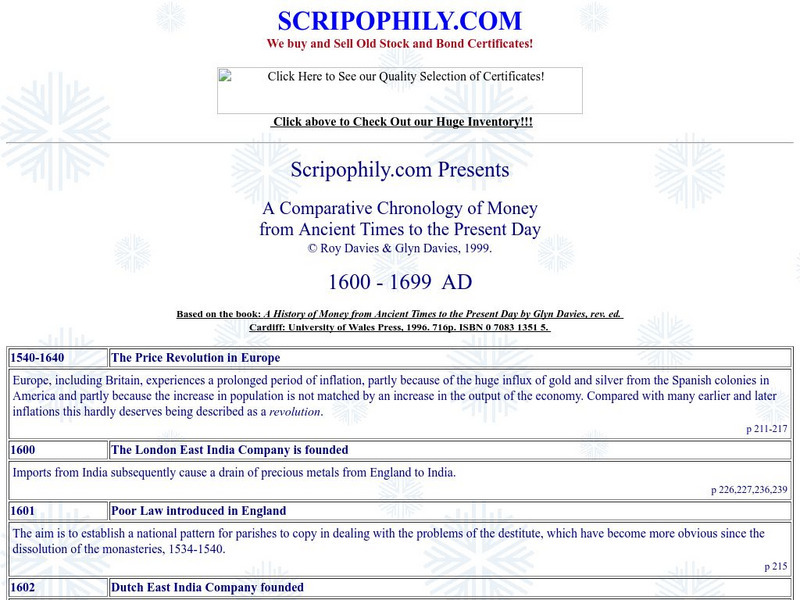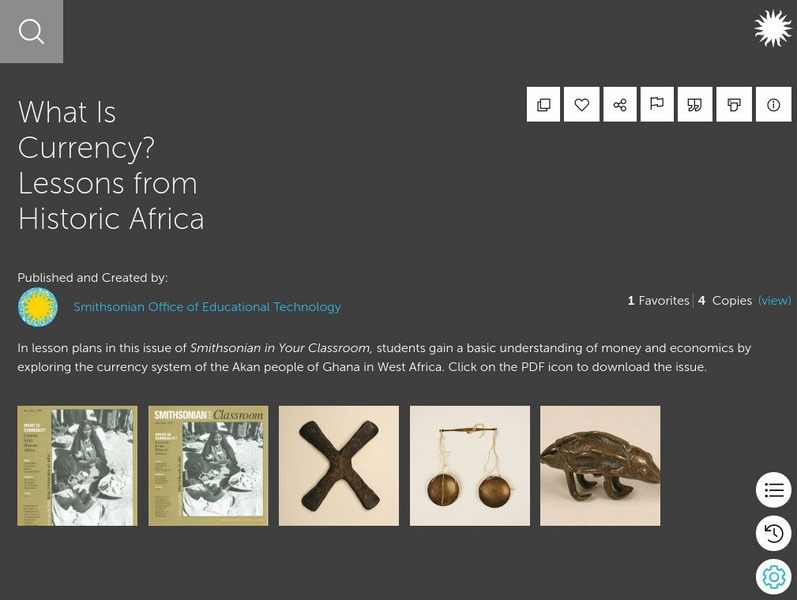Council for Economic Education
Econ Ed Link: Lewis and Clark Barter With Native Americans
In this lesson you will define the term barter and give examples of bartering in several different areas. Find out how this system took shape and was useful to Lewis and Clark. This site is extremely informative and contains extension...
Council for Economic Education
Econ Ed Link: Hawaiian Economics: Barter for Fish & Poi
Use this lesson to learn more about the Hawaiian economics system. Learn how they developed and used this specialized type of money system. "In this lesson, you will learn how specialization and division of labor increased productivity...
Middlebury College
Middlebury College: Trade and Barter in Ancient Greece
Middlebury College provides an essay that uses ancient Greek mythology to explain how the Greeks viewed economic practices like trading and bartering.
Council for Economic Education
Econ Ed Link: Money or Barter?
Economics website with interactive lesson teaching students the characteristics of money and barter. Students will be asked to categorize statements as money, barter, or both.
Federal Reserve Bank
Federal Reserve Bank of Atlanta: Building Block Barter Lesson
Lesson plan for 3 - 5 graders about the advantages of using money instead of bartering.
Council for Economic Education
Econ Ed Link: Lewis and Clark Barter With the Native Americans
Using the study of the Lewis and Clark expedition students will define the term barter and give examples of bartering.
The Franklin Institute
Franklin Institute: Bartering for Goods
The Franklin Institute Online explains what bartering is and how it developed down through history. A lesson plan and quiz are also provided.
Council for Economic Education
Econ Ed Link: Hawaiian Economics: Barter for Fish & Poi
In ancient Hawaii, chiefs managed the economy by creating a land division system, the Ahupua'a, which divided the islands into pie slice shapes. Each Ahupua'a covered the three main regions of the islands: the mountains, the valleys, and...
Education.com
Education.com: Goods and Services: Let's Make a Deal!
[Free Registration/Login Required] Have your students experience the act of trading goods and services with bartering. In this activity, students will have the opportunity to make a deal, in order to get what they want. Better yet, make...
Online Learning Haven
Fun Social Studies: How Money Began
A brief history of the barter system and how coins and currency came into use. Includes links to related topics on the use of money.
Edutopia
Edutopia: Goods and Services [Pdf]
A unit that teaches the difference between goods and services, the difference between producers and consumers, the difference between human, natural, and capital resources, and the difference between bartering/trading and buying/selling....
Council for Economic Education
Econ Ed Link: Bill, Are You Bogus?
In a barter system, people have to trade goods and services for other goods and services. In an economy that produces millions of goods and services, barter is very difficult. Think of all the stuff (goods and services) you have.
Council for Economic Education
Econ Ed Link: I Have No Money, Would You Take Wampum?
Through the use of folk tales, history, and the students' own experiences, students will recognize the inter-relatedness of goods, services, money. They will locate information about barter as a means of trade, use folk tales as an...
Federal Reserve Bank
Federal Reserve Bank of Philadelphia: What Is Money? [Pdf]
This lesson plan is designed to help children understand the problems which arise from the bartering system so they appreciate the role money has in society.
Other
Scripophily: A Comparative Chronology of Money
Site provides various segments of historical dates from early Babylonian times to present. Time periods provide information about culture and the form of monetary exchange or bartering that took place.
Federal Reserve Bank
Federal Reserve Bank of Philadelphia: Why Money? [Pdf]
Young scholars learn about barter, and the benefits of using money, as they participate in this trading simulation.
Smithsonian Institution
Smithsonian Education: Why Use Money? Getting What We Need
Students will compare and contrast different methods of attaining the everyday items they need. Using the Akan people of Africa as an example of bartering, students will understand three different ways of paying for goods. Discussion...
Smithsonian Institution
Smithsonian Learning Lab: What Is Currency? Lessons From Historic Africa
From the Smithsonian, this site offers lessons and resources on currency, its use (in the form of gold dust, salt, or metal objects) as an instrument of trade in historic Africa, and its requirements as an instrument of trade in the...
Smithsonian Institution
National Museum of American History: Legendary Coins and Currency
Archived images of coins from a beautiful online exhibition on the history of money.
Better Lesson
Better Lesson: Want to Trade?
Students will write about what they would trade for gold and practice inventive spelling in the process. After reading "In 1492", students will discuss how Christopher Columbus traded with the natives and then write what they would trade...
University of Nebraska Omaha
Ec Ed Web: Virtual Economics Web Companion
The Virtual Economics Web Companion for K-12 economics and social studies teachers was created by the National Council on Economic Education. A wide variety of educational materials and lesson plans can be accessed through this site....
Federal Reserve Bank
Federal Reserve Bank of Atlanta: Classroom Economist: What Is Money?
In this edition, the Classroom Economist offers a close look at money-its definition, the problem it solves, what fiat money accomplishes, and how the Yapese used giant wheels of stone for money.
Other
Federal Bank of Richmond: My Money
For elementary students, this booklet of activities teaches basic money skills and concepts. Includes lesson plans.
Council for Economic Education
Econ Ed Link: Trade to the Tailor: Student Version
Students can use this site online in conjuction with the teacher's lesson plan, "Trade to the Tailor."







![Federal Reserve Bank of Philadelphia: What Is Money? [Pdf] Lesson Plan Federal Reserve Bank of Philadelphia: What Is Money? [Pdf] Lesson Plan](http://content.lessonplanet.com/resources/thumbnails/409977/large/bwluav9tywdpy2symdiwmduymc0xmdq5ny16ejvsywouanbn.jpg?1589982800)

![Federal Reserve Bank of Philadelphia: Why Money? [Pdf] Lesson Plan Federal Reserve Bank of Philadelphia: Why Money? [Pdf] Lesson Plan](http://content.lessonplanet.com/resources/thumbnails/409976/large/bwluav9tywdpy2symdiwmduymc0xmdm5ny0xdnbua3j3lmpwzw.jpg?1589982798)



